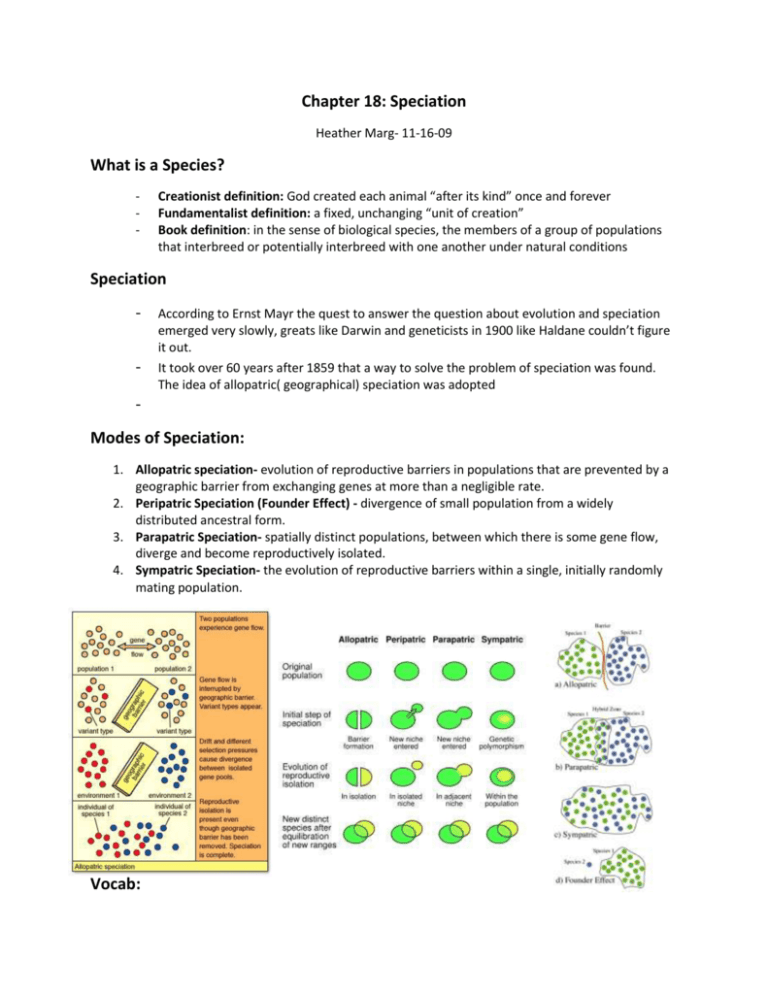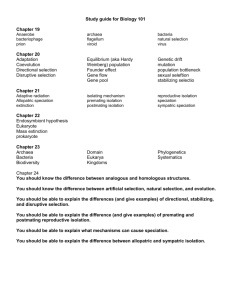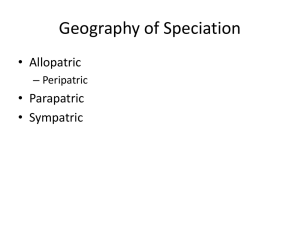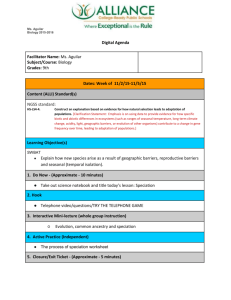Modes of Speciation
advertisement

Chapter 18: Speciation Heather Marg- 11-16-09 What is a Species? - Creationist definition: God created each animal “after its kind” once and forever Fundamentalist definition: a fixed, unchanging “unit of creation” Book definition: in the sense of biological species, the members of a group of populations that interbreed or potentially interbreed with one another under natural conditions Speciation - According to Ernst Mayr the quest to answer the question about evolution and speciation emerged very slowly, greats like Darwin and geneticists in 1900 like Haldane couldn’t figure it out. It took over 60 years after 1859 that a way to solve the problem of speciation was found. The idea of allopatric( geographical) speciation was adopted Modes of Speciation: 1. Allopatric speciation- evolution of reproductive barriers in populations that are prevented by a geographic barrier from exchanging genes at more than a negligible rate. 2. Peripatric Speciation (Founder Effect) - divergence of small population from a widely distributed ancestral form. 3. Parapatric Speciation- spatially distinct populations, between which there is some gene flow, diverge and become reproductively isolated. 4. Sympatric Speciation- the evolution of reproductive barriers within a single, initially randomly mating population. Vocab: *Vicariance- Separation of a continuously distributed ancestral population or species into separate populations due to the development of a geographic or ecological barrier. *Ecological Speciation- evolution of barriers to gene flow caused by divergent ecologically based selection. * Reinforcement- the enhancement of prezygotic barriers. * Character Displacement- a pattern whereby characters differ more where two taxa are sympatric then when they are allopatric. * Founder Effect Speciation- Peripatric speciation Allopatric Speciation - A physical barrier reduces gene flow to such a degree that if they were to come into contact again, no interbreeding would occur. Can occur “microgeographically” in species that disperse very little or favor a certain habitat Allopatric populations can expand their range and come into contact again and become sympatric without exchanging genes. The new population that evolves from the parent population is called an incipient species Evidence for Allopatric Speciation -Dusky Salamander- experiment conducted by Stephen Tilly- They brought male and female salamanders from different and same populations and mated them. They found that the further apart the males and females in the pairs came from, the more genetically different they were, and the less likely they were to breed. - Speciation often occurs with the appearances of geographical barriers, for example mountains. Role of Natural Selection - Causes the evolution of genetic differences that create incompatibility between species. Role of Ecological Selection - Ecologically divergent characters are thought to play a role in reproductive isolation. o Ex) Two species of Monkeyflowers that have become adapted to different pollinators. Role of Sexual Selection - Closely related species are often sexually isolated by a females preference in males, there are two hypotheses for this: o This enables the females to recognize conspecific mates and reduce hybridization which would reduce the fitness of potential offspring o Divergent sexual selection in different geographic populations of species result in different male traits and females preferences for them Alternatives to Allopatric Speciation - Peripatric o o One of Ernst Mayr’s most controversial hypotheses Mandy birds and animals have populations in areas very close to that of the “parent” species, but similar but are classified as different species; species evolve as localized “buds” from a widespread parent species - Parapatric o Can happen when two populations share a border and some hybridization at that point by some individuals. Steady genetic divergence could eventually result in reproductive isolation - Sympatric o o o Highly controversial subject. Ernst Mayr was the most influential critic of this model. When two populations share the same space and were initially a randomly mating population. A biological barrier to gene exchange arises from within the population and they still share the same space Has been seen in a few laboratory cases of Drosophila Polyploidy and Recombinational Speciation Polyploidy *usually occurs because of a failure during reproductive division in meiosis. *The diploid hybrids of species are mostly sterile (Ligers, Mules) *Tetraploid offspring of these hybrids happen to be highly fertile Recombinational Hybridization sometimes gives rise to distinct species with the same number of chromosomes as their parents. Certain genotypes may be fertile but reproductively isolated from the parent species, once this happens in a population that genotype can increase in occurrence and a new species can arise Rate of Speciation - The rate that speciation occurs at is primarily determined by ecological factors When a species is separated by a geographical barrier, speciation is rapid There are species that speciate rarely or very slowly, this gives rise to “living fossils” (Ginkgo, Aardvark, Tuatara, Coelacanth) Bibliography Futuyma, Douglas J. Evolution 2nd ed. Sunderland, MA: Sinauer Associates Inc., 2009. Print. Mayr, Ernst. What Evolution Is. New York: Basic Books, 2002. Print. Milner, Richard. Encyclopedia of evolution humanity's search for its origins. New York: Facts on File, 1990. Print. Pictures: http://bio.research.ucsc.edu/~barrylab/classes/animal_behavior/IMAGES4.DIR/SPECMODE.GIF http://bio100.nicerweb.com/Locked/media/ch21/allopatric_speciation.jpg http://www.uwyo.edu/dbmcd/molmark/Speciation_modes.png









